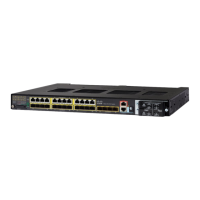497
Cisco Systems, Inc. www.cisco.com
Configuring Layer 2 NAT
One-to-one (1:1) Layer 2 Network Address Translation (NAT) is a service that allows the assignment of a unique public
IP address to an existing private IP address (end device), so that the end device can communicate on both the private
and public subnets. This service is configured in a NAT-enabled device and is the public “alias” of the IP address
physically programmed on the end device. This is typically represented by a table in the NAT device.
Layer 2 NAT has two translation tables where private-to-public and public-to-private subnet translations can be defined.
Layer 2 NAT is a hardware based implementation that provides the same high level of (bump-on-the-wire) wire-speed
performance. This implementation also supports multiple VLANs through the NAT boundary for enhanced network
segmentation.
For information about configuring Layer 2 NAT on a Cisco Industrial Ethernet Switch, see Layer 2 NAT Software
Configuration Guide for Cisco Industrial Ethernet Switches.
Note - The IE 4010 and 5000 follow the same rules documented in the Layer 2 Nat guide.

